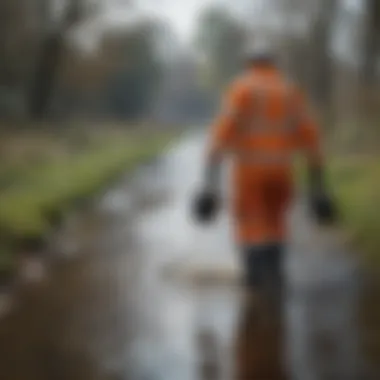Expert Guide: Who to Call for a Sewage Leak Situation


Overview of the Topic
Sewage leaks can pose significant risks to both the environment and human health, making it crucial to understand who to contact in such emergencies. When faced with a sewage leak situation, quick and appropriate action is vital. This comprehensive guide delves into the key points individuals need to grasp when encountering sewage-related issues to effectively manage and mitigate potential risks.
Current Status and Challenges
In today's context, sewage leaks remain a prevalent environmental concern with far-reaching implications. The improper handling of sewage can lead to contamination of water sources, soil degradation, and various health hazards. Challenges such as outdated infrastructure, inadequate maintenance, and lack of awareness further exacerbate these issues, emphasizing the pressing need for a well-informed and proactive approach.
Sustainable Solutions
Exploring sustainable practices is imperative in addressing sewage leak challenges. Implementing proper sewage treatment methods, regular maintenance of sewage systems, and engaging in eco-friendly wastewater management are pivotal steps towards sustainable solutions. Case studies showcasing successful sewage management practices offer valuable insights into effective resource utilization and environmental protection.
Impact and Importance
The impact of sewage leaks extends beyond immediate environmental consequences to affect ecosystems, communities, and future generations. Contaminated water sources can lead to the disruption of aquatic ecosystems, endangering both wildlife and human populations. Recognizing the importance of conservation efforts and sustainable resource management is crucial in safeguarding the environment and promoting the well-being of all life forms.
Understanding Sewage Leaks
Understanding sewage leaks is crucial for homeowners and property managers. It involves knowing the causes, risks, and signs of potential leaks, which can help in early detection and prevention of serious damage. By comprehending sewage leaks, individuals can take proactive measures to safeguard their health, property, and the environment. This section aims to explore the various aspects of sewage leaks to equip readers with the knowledge needed to respond effectively to such emergencies.
Causes of Sewage Leaks
Pipe Corrosion
Pipe corrosion is a common cause of sewage leaks in residential and commercial buildings. Over time, pipes may deteriorate due to environmental factors, leading to cracks and leaks. The key characteristic of pipe corrosion is its gradual progression, often unnoticed until significant damage occurs. While pipe corrosion is a silent threat, regular inspections and maintenance can help mitigate its impact. Understanding pipe corrosion is essential as it highlights the importance of preventative measures in sewer system maintenance.
Tree Root Intrusions
Tree root intrusions occur when tree roots penetrate sewer pipes in search of water and nutrients. This intrusion can result in blockages and structural damage to the pipes, leading to sewage leaks. The unique feature of tree root intrusions is their ability to cause localized damage that may escalate if left unattended. Managing tree root intrusions involves using techniques such as root cutting and sewer lining to prevent further damage. Awareness of this cause is vital for addressing underlying issues in sewage systems.
Clogs and Blockages
Clogs and blockages in sewer lines are often caused by non-biodegradable items, grease buildup, or mineral deposits. These blockages can lead to sewer backups and potential leaks if not resolved promptly. The key characteristic of clogs and blockages is their sudden onset, causing immediate disruptions to plumbing systems. By understanding the causes of clogs and blockages, individuals can adopt preventive practices like proper waste disposal and regular drain maintenance.
Risks and Dangers
Health Hazards
Sewage leaks pose significant health hazards, ranging from exposure to harmful pathogens to respiratory issues. The key characteristic of health hazards associated with sewage leaks is their potential to cause both short-term and long-term health problems. Understanding these risks underscores the importance of prompt remediation and professional sanitation to mitigate health threats. By addressing health hazards effectively, individuals can protect themselves and their families from the adverse effects of sewage exposure.


Water Contamination
Water contamination is a major concern linked to sewage leaks, as contaminated water can spread harmful bacteria and pollutants. The unique feature of water contamination is its capacity to affect not only the immediate environment but also public health if untreated. Recognizing the risks associated with water contamination underscores the need for preventive actions like water testing and filtration. Addressing water contamination promptly can prevent widespread contamination and its associated dangers.
Property Damage
Sewage leaks can result in extensive property damage, including structural deterioration, mold growth, and compromised foundation. The key characteristic of property damage is its costly and time-consuming remediation process, impacting homeowners financially and emotionally. Understanding the risks of property damage emphasizes the importance of quick intervention and thorough restoration efforts. By addressing property damage proactively, individuals can minimize the impact of sewage leaks on their homes and valuables.
Signs of a Sewage Leak
Foul Odors
Foul odors, such as the smell of rotten eggs or sulfurous gases, are indicative of a potential sewage leak. The key characteristic of foul odors is their distinct scent that often lingers in affected areas. Recognizing foul odors alerts individuals to potential sewage leaks, prompting immediate action to prevent further damage. By understanding the significance of foul odors, individuals can detect leaks early and seek professional assistance to address the issue promptly.
Slow Draining Fixtures
Slow draining fixtures, such as sinks and showers, can signal blockages or leaks in the plumbing system. The unique feature of slow draining fixtures is their gradual decrease in water drainage, indicating underlying issues with the sewer lines. Identifying slow draining fixtures helps individuals identify potential leaks before they escalate, allowing for timely repairs and preventive measures. By observing and addressing slow draining fixtures, homeowners can prevent extensive damage and costly repairs.
Soggy Patches in Yard
Soggy patches in the yard, especially in areas above sewer lines, can indicate an underground sewage leak. The key characteristic of soggy patches is the presence of damp, sunken areas without logical explanation, potentially signaling a breach in the sewer system. Recognizing soggy patches in the yard prompts individuals to investigate further and seek professional assistance to address the leak promptly. Understanding the significance of soggy patches helps homeowners protect their property and prevent widespread water damage.
Immediate Actions to Take
When facing a sewage leak, taking immediate action is crucial to mitigate risks and prevent further damage. The section 'Immediate Actions to Take' outlines the essential steps to address the emergency effectively. From ensuring safety to minimizing the impact, these actions play a vital role in managing the situation promptly and efficiently.
Safety Precautions
Evacuate the Area
Evacuating the contaminated area is a fundamental safety precaution to safeguard individuals from exposure to harmful pathogens and contaminants present in sewage. This action helps prevent health risks and ensures the well-being of those in the vicinity, minimizing the chance of infections or illnesses due to contact with unsanitary sewage.
Avoid Contact with Sewage
Avoiding direct contact with sewage is paramount in reducing the transmission of diseases and preserving personal health. By refraining from contact with sewage water or contaminated surfaces, individuals can lower the risk of infections and prevent the spread of bacteria and viruses commonly found in untreated wastewater.
Turn Off Electrical Sources
Turning off electrical sources in the affected area is critical to prevent electrocution hazards and minimize the risk of electrical fires. By isolating the power supply, individuals can eliminate the danger of electric shocks caused by contact between water and live electrical components, ensuring safety amid the sewage leak crisis.
Contacting the Professionals


When dealing with a sewage leak, seeking assistance from experts is vital to address the issue effectively. Contacting the right professionals can make a significant difference in resolving the emergency promptly and restoring the impacted area to a safe condition.
Local Water Department
The local water department plays a crucial role in responding to sewage-related incidents by providing insights, guidance, and support in managing sewage leaks. Their expertise in wastewater management and infrastructure enables them to offer valuable assistance in assessing the situation and formulating appropriate solutions to contain and resolve the leak.
Certified Plumber
A certified plumber possesses the necessary skills and experience to address sewage leaks efficiently, identify the source of the problem, and implement effective repairs. Engaging a certified plumber ensures that the leak is professionally handled, reducing the risk of further damage to the property and ensuring the restoration of proper sewage system functionality.
Emergency Restoration Services
In situations where extensive damage has occurred due to the sewage leak, engaging emergency restoration services is essential. These specialized services are equipped to handle large-scale cleanup, sanitation, and restoration, ensuring the thorough remediation of the affected area and the implementation of measures to prevent future incidents.
Documenting the Damage
Documenting the damage caused by the sewage leak is instrumental in facilitating insurance claims and assessing the extent of the impact. Through meticulous documentation, individuals can establish the scope of the damage, track restoration efforts, and expedite the insurance process for adequate coverage.
Photographing Affected Areas
Capturing photographs of the affected areas serves as visual evidence of the damage, providing clarity on the condition of the property pre and post-cleanup. These images are valuable in showcasing the extent of the impact, supporting insurance claims, and documenting the restoration progress for reference.
Maintaining Records for Insurance
Maintaining detailed records of the sewage leak incident, including repair invoices, cleanup costs, and communication with professionals, is crucial for insurance purposes. These records serve as documentation of the expenses incurred, services rendered, and the overall impact of the leak, facilitating smoother claim processing and comprehensive coverage assessment.
Post-Leak Remediation
First and foremost, post-leak remediation is a critical aspect of dealing with a sewage leak. In the grand scheme of this article, it holds immense significance due to its role in restoring the impacted area's safety and cleanliness. The post-leak remediation phase involves a series of actions geared towards cleaning up the mess left behind by the leak and disinfecting the surroundings. This segment addresses the aftermath of the sewage leak and emphasizes the necessity of proper remediation strategies.
Cleaning and Disinfecting
When it comes to cleaning and disinfecting after a sewage leak, two key components stand out: professional sanitization and proper waste disposal. These elements are vital in ensuring that the affected area is thoroughly sanitized and free from any contaminants that could pose health risks. Let's delve into each of these components in detail:
Professional Sanitization
Professional sanitization plays a pivotal role in post-leak remediation. It involves the use of specialized equipment and cleaning agents to sanitize the affected area thoroughly. This method ensures that all traces of bacteria and pathogens are eradicated, reducing the risk of any lingering health hazards. While professional sanitization may incur additional costs, its effectiveness in ensuring a safe environment justifies the investment.
Proper Waste Disposal
Proper waste disposal is another crucial aspect of cleaning and disinfecting post a sewage leak. Waste generated from the cleanup process must be handled and disposed of following appropriate guidelines to prevent further contamination and environmental harm. Disposing waste in a responsible and eco-friendly manner not only protects the environment but also safeguards public health. It is imperative to work with waste disposal professionals who adhere to regulatory standards to ensure proper waste management.


Preventative Measures
Implementing preventive measures is key to avoiding future sewage leaks and minimizing the risk of similar incidents. Within this article's context, two crucial preventative measures are emphasized: regular inspections and upgrading sewage systems.
Regular Inspections
Regular inspections of sewage systems help in early detection of potential issues that could lead to leaks or blockages. By conducting routine checks, property owners can identify and address minor problems before they escalate into major crises. This proactive approach to maintenance can save time, money, and prevent the inconvenience of dealing with sudden sewage leaks.
Upgrading Sewage Systems
Upgrading sewage systems to modern, more efficient models is a proactive step towards preventing leaks and improving overall system performance. Whether it involves replacing old pipes, enhancing drainage systems, or incorporating advanced technologies, upgrading sewage systems can enhance resilience against leaks and minimize the likelihood of disruptions. Investing in system upgrades is an investment in the long-term functionality and sustainability of sewage infrastructure.
Seeking Health Consultation
In the aftermath of a sewage leak, seeking health consultation is essential to address any potential health risks and symptoms that may arise. This section highlights two critical aspects of seeking health consultation: medical check-ups and reporting symptoms.
Medical Check-ups
Undergoing medical check-ups post exposure to sewage can help identify any health issues early on. Medical professionals can assess individuals for any signs of infection or illness resulting from exposure to sewage contaminants. Prompt medical check-ups can facilitate timely treatment and prevent health conditions from worsening.
Reporting Symptoms
Reporting symptoms related to a sewage leak is vital for tracking and managing potential health impacts. Individuals experiencing unusual symptoms post-exposure should promptly report them to healthcare providers for accurate diagnosis and treatment. By documenting and sharing symptoms, health authorities can monitor public health trends and provide appropriate interventions when necessary.
Conclusion
In the exhaustive exploration of Who to Call for a Sewage Leak, the Conclusion stands as a vital segment encompassing essential details for dealing with such emergencies efficiently. Understanding the significance of staying prepared resonates strongly in this article, reinforcing the necessity of proactive measures. By delving into the two crucial components, Staying Prepared and Environmental Impact Awareness, this section enhances readers' comprehension of the holistic approach required in sewage leak scenarios. The paramount importance lies in preparedness, enabling individuals to mitigate risks effectively and tackle unforeseen challenges with resilience.
Staying Prepared
Emergency Contacts List
The Emergency Contacts List serves as a cornerstone in the preparedness strategy detailed in this guide. Highlighting this esteemed section is critical in fostering proactive response mechanisms to sewage leaks. The key characteristic of the Emergency Contacts List lies in its curated compilation of essential numbers and contacts, ranging from water department helplines to emergency restoration services. Its fundamental role stems from providing swift access to pertinent agencies and professionals, streamlining the initial response phase during sewage-related crises. A commendable aspect of this feature is its versatility, catering to diverse geographical locations and varying severity levels of leaks. Despite its prominence in this guide, it is imperative to acknowledge the transient nature of contact information, necessitating periodic updates to ensure optimal utility.
Educating Household Members
Educating Household Members emerges as a pivotal element contributing significantly to the overarching objective of preparedness highlighted in this article. The crux of this component revolves around empowering individuals within a household to recognize and respond effectively to sewage leak incidents. The salient feature of this educational initiative lies in its emphasis on disseminating knowledge regarding early warning signs, safety protocols, and communication channels. By fostering a culture of awareness and readiness among household members, the potential for minimizing hazards and expediting response times amplifies substantially. A noteworthy advantage of this approach is its capacity to instill a sense of responsibility and collaboration within the household, fostering a collective resilience against unforeseen sewage-related challenges.
Environmental Impact Awareness
Sustainable Practices
Sustainable Practices emerge as a cornerstone in the environmental impact awareness campaign encapsulated in this article. This specific aspect underscores the adoption of eco-conscious methodologies in sewage management and remediation efforts. The key characteristic of Sustainable Practices lies in their ability to harmonize sewage leak response with environmental preservation, encouraging the implementation of eco-friendly solutions. A notable advantage of integrating Sustainable Practices in sewage leak protocols is the holistic approach it brings to mitigating the ecological repercussions of such incidents. Despite its commendable merits, challenges such as initial costs and infrastructural upgrades may present as potential deterrents, highlighting the need for strategic planning and long-term vision in embracing these practices.
Waste Reduction Initiatives
Waste Reduction Initiatives form a crucial component of the environmental impact mitigation strategies elucidated in this discourse. Emphasizing the reduction of waste output and optimal resource utilization, this initiative is instrumental in mitigating the ecological footprint of sewage leaks. The key characteristic of Waste Reduction Initiatives lies in their propensity to minimize environmental degradation by advocating for responsible waste management practices. A unique feature of these initiatives is their potential to foster community engagement and advocacy, bolstering collective efforts to combat environmental degradation. While the advantages of Waste Reduction Initiatives are evident in promoting sustainability and resource efficiency, the challenges of regulatory compliance and logistical constraints necessitate a nuanced approach to implementation within sewage leak response frameworks.

